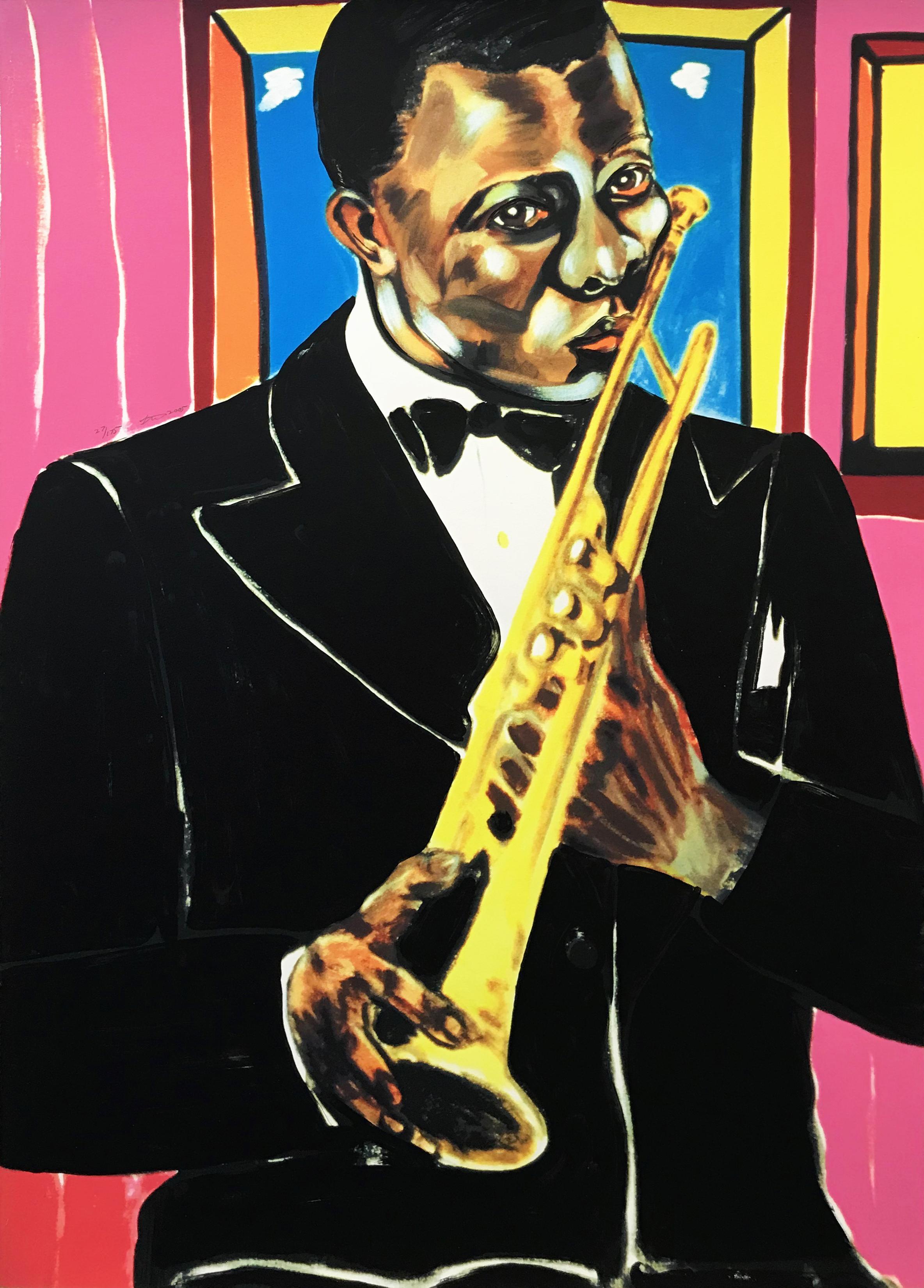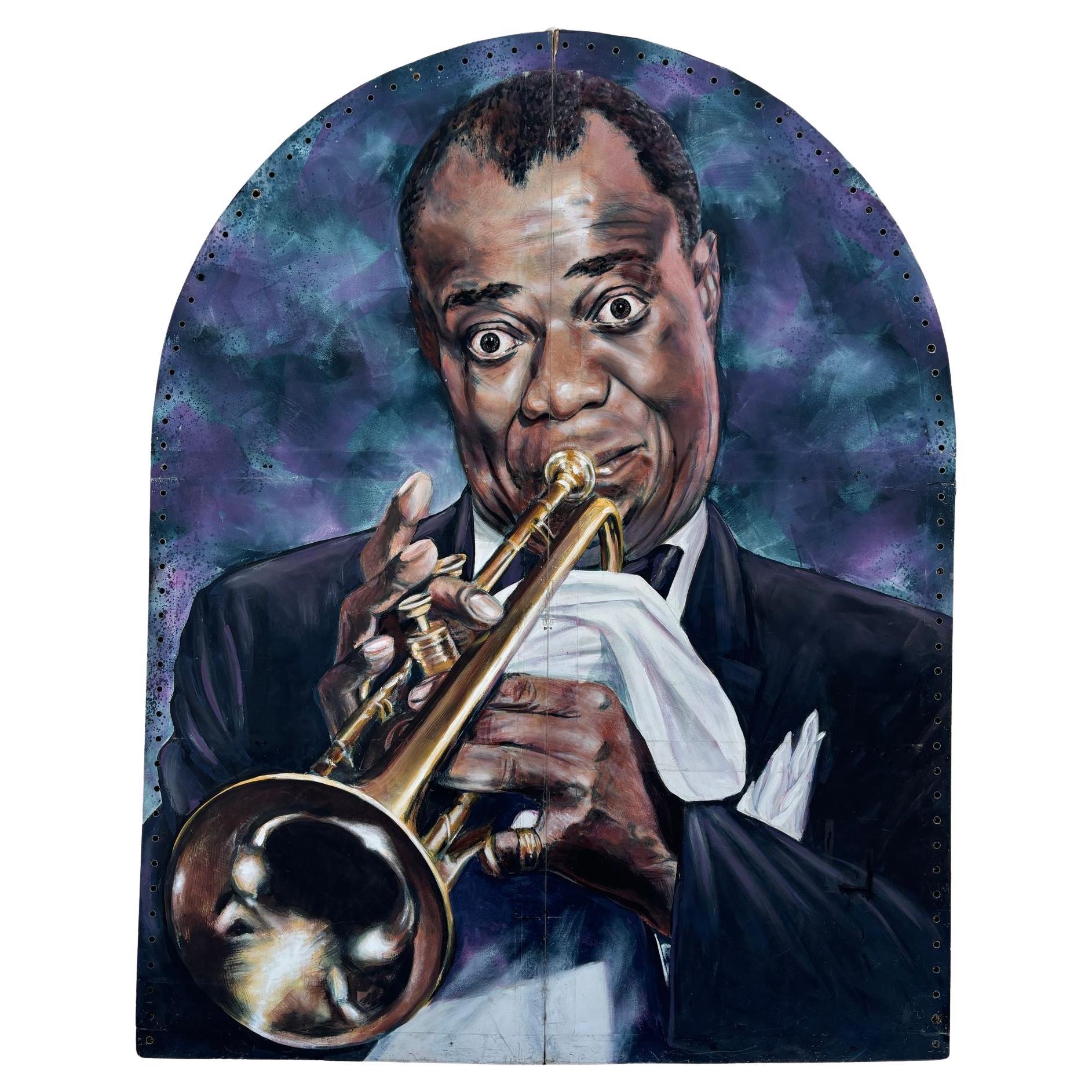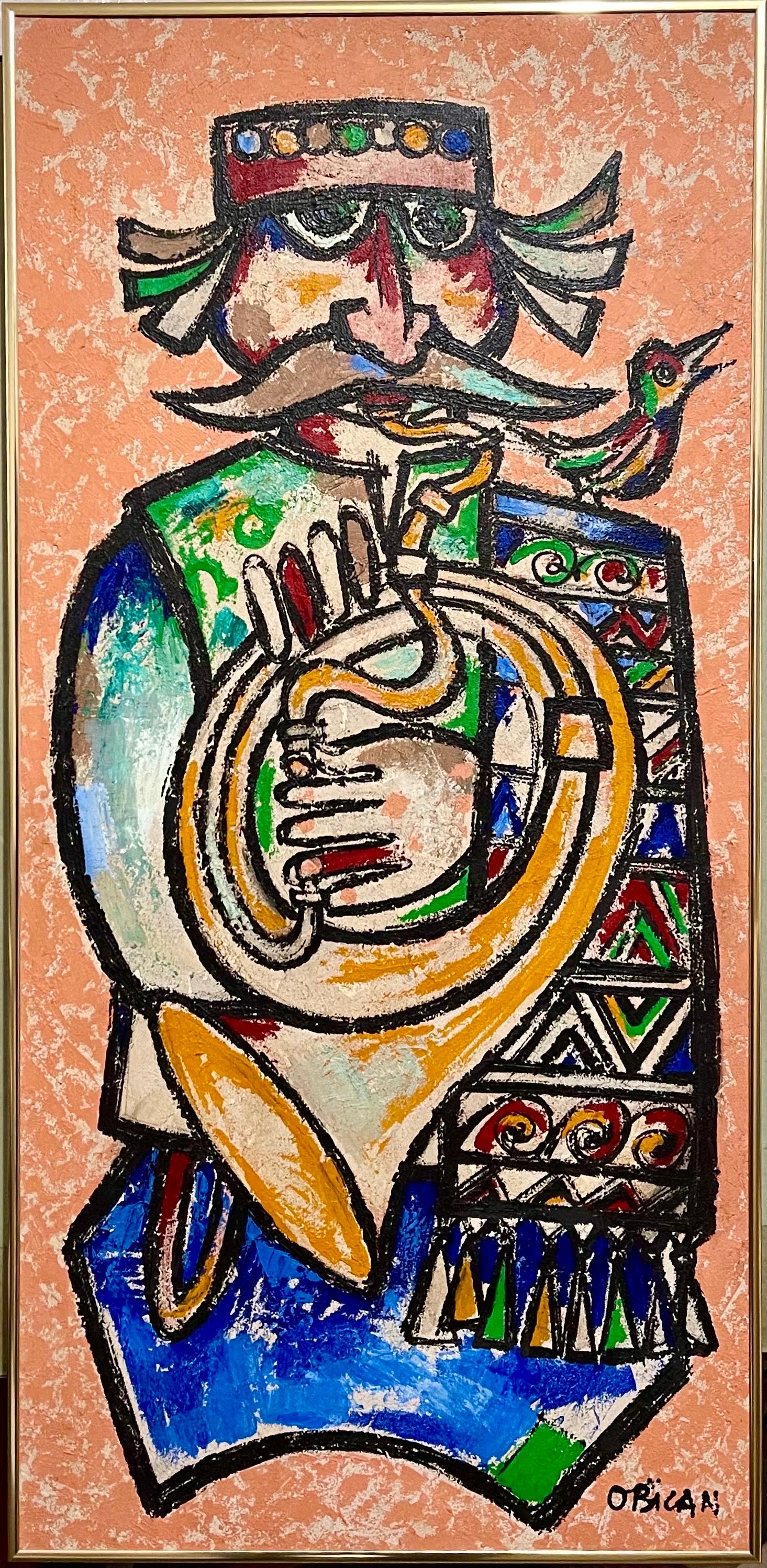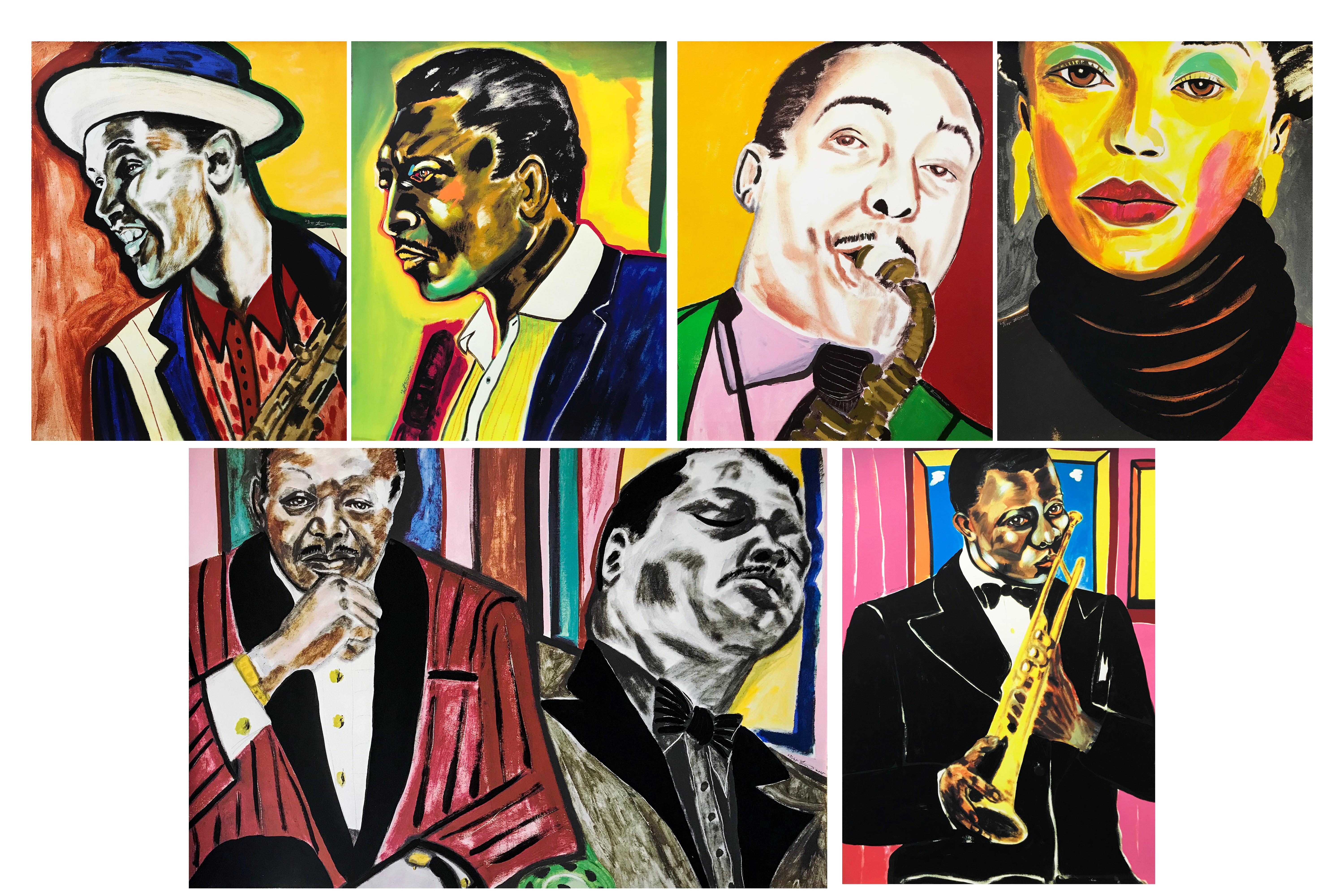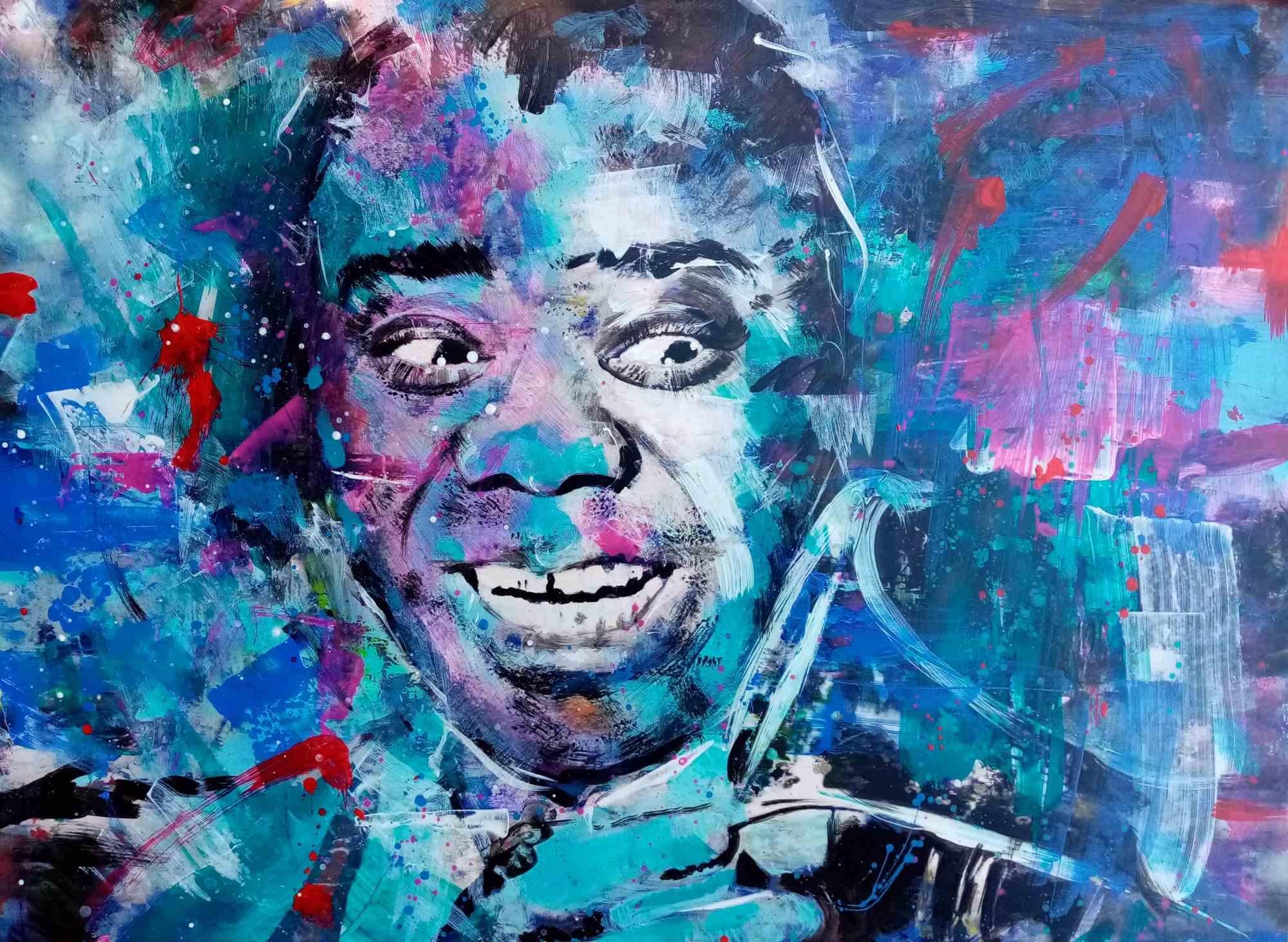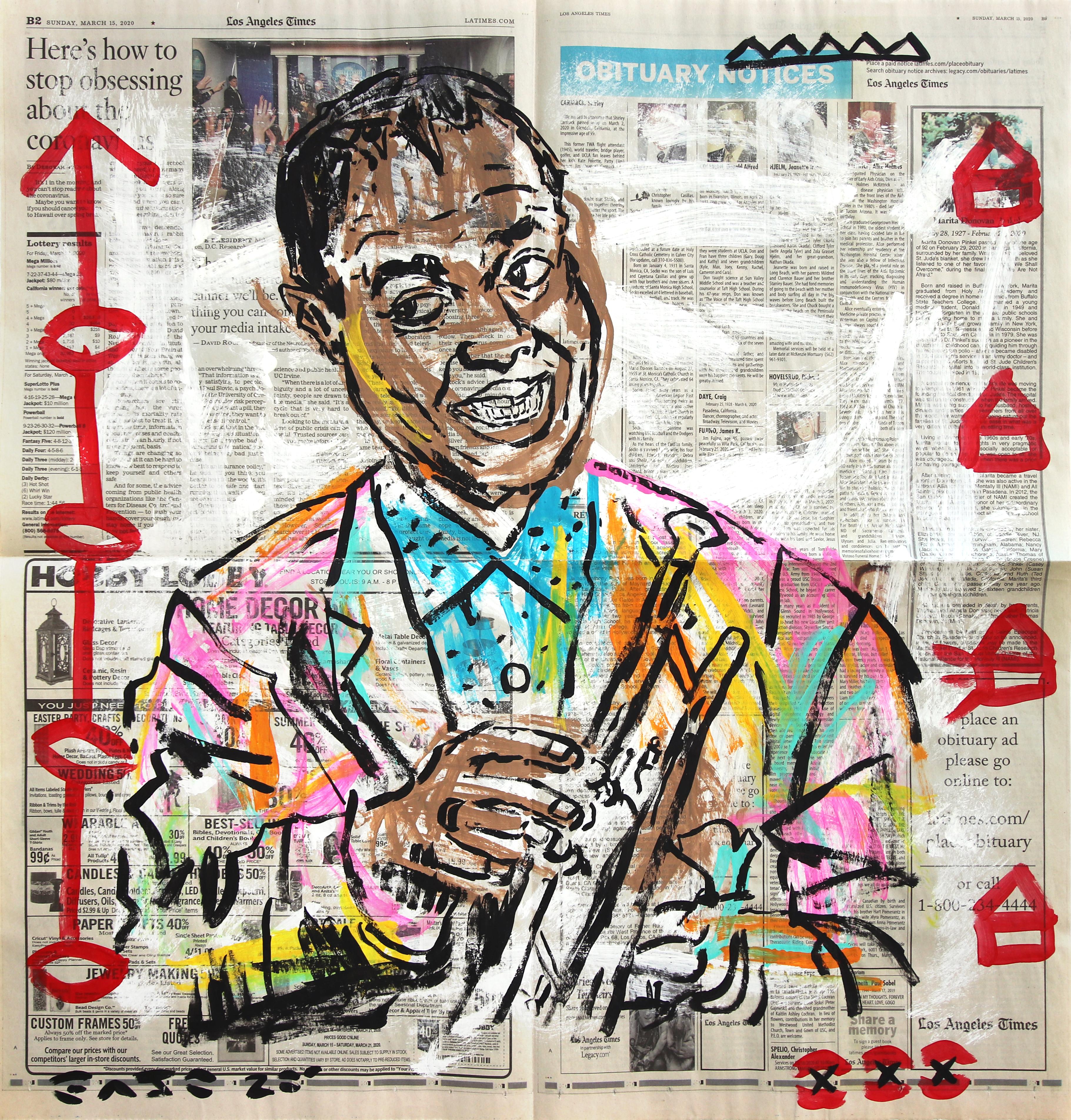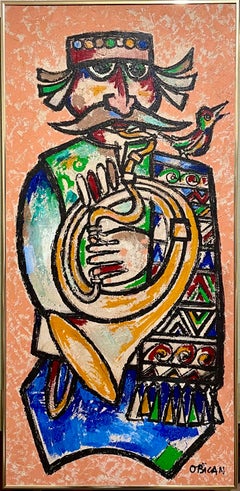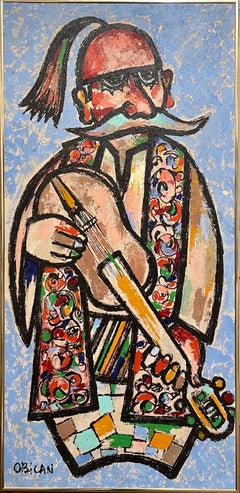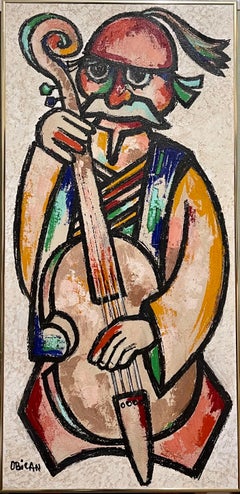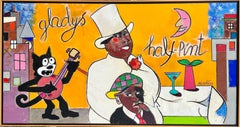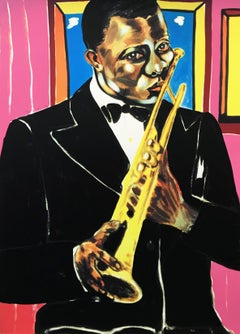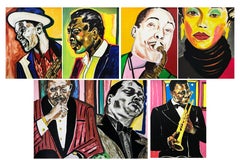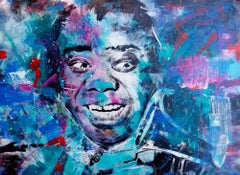Items Similar to Large Malcah Zeldis Folk Art Oil Painting Jazz Great "Satchmo" Louis Armstrong
Want more images or videos?
Request additional images or videos from the seller
1 of 15
Malcah ZeldisLarge Malcah Zeldis Folk Art Oil Painting Jazz Great "Satchmo" Louis Armstrong1974
1974
$12,500
£9,441.30
€10,911.42
CA$17,533.16
A$19,501.38
CHF 10,206.60
MX$237,852.53
NOK 128,249.70
SEK 120,635.40
DKK 81,443.18
About the Item
Swing Jazz Quartet. Satchmo, Louis Armstrong!
Oil Painting on board. Hand signed and dated 1974
Malcah Zeldis (born Mildred Brightman; 1931) is an American folk art painter. She is known for work that draws from a mix of biblical, historical, and autobiographical themes. She is one of the leading self-taught contemporary artists, best known for her paintings depicting urban life, historical and religious events, her heroes, and her own life. Her paintings have been widely exhibited. Her work is in the collection of the Smithsonian American Art Museum and was used for the invitation and posters for the traveling exhibition: American Art on the Move which toured museums during 2001. Of special note is the one-person show presented by the Museum of American Folk Art at New York University in 1988. It was the first time the museum had presented a one-person exhibition of the work of a living folk artist.
Malcah Zeldis was born in the Bronx, New York, and raised in a Jewish ghetto in Detroit, Michigan. Her father faced work discrimination for his religion and the family was poor, but eventually moved to a middle-class neighborhood. However, Zeldis looks back on her years in Detroit fondly, stating that what she remembers best is the nature. She also remembers weekend visits to the Detroit Institute of Arts where she recalls being taken by brightly colored Flemish paintings full of small figures. These paintings would later inspire her colorful works with many small figures.
As a non-devout Jew, Zeldis felt disconnected from her people and wanted to explore her heritage. She moved to Israel in 1949 at the age of eighteen, becoming a Zionist and working on a kibbutz. It was here that Zeldis met her future husband, Hiram Zeldis. The two went back to the US to marry, and then returned to the kibbutz. Zeldis began painting, yet had little confidence in the quality of her work. However, Aaron Giladi, a well known Israeli artist visited the kibbutz and praised Zeldis’s paintings. His suggestion to paint larger intimidated Zeldis. After trying and failing to use larger canvases she stopped painting for a period of time, which was extended by childbirth and a permanent move to Brooklyn, New York. Zeldis finally resumed painting twenty-three years later, as her children grew older and her marriage ended. She enrolled in Brooklyn College as an Early Childhood Studies major in 1970. The college had a "life experience" policy, which prompted Zeldis to submit her paintings despite continued apprehension over whether they were good enough. Much to her surprise, Zeldis's paintings were well received and her teacher introduced her work to an art critic, who further suggested showing her work to dealers. This period was a turning point for Zeldis, as she realized that her lack of training was not a barrier to the art world. It was around this time that she observed Haitian folk art in a gallery. She found Haitian folk art very stylistically similar to her own, and finally believed that she was an artist. Zeldis began painting seriously and had a number of gallery shows. Her work also appeared in books such as the International Dictionary of Naive Art and Moments in Jewish Life: The Folk Art of Malcah Zeldis. Zeldis later worked in children's book illustration in collaboration with her daughter, Yona Zeldis. Her naive, whimsical images contain a number of storytelling devices and attempt to convey a narrative.
Louis Armstrong (1901 – 1971), nicknamed "Satchmo", "Satch", and "Pops", was an American trumpeter and vocalist. He is among the most influential figures in jazz. His career spanned five decades and different eras in the history of jazz.
Armstrong was born and raised in New Orleans. Coming to prominence in the 1920s as an inventive trumpet and cornet player, Armstrong was a foundational influence in jazz, shifting the focus of the music from collective improvisation to solo performance. Around 1922, he followed his mentor, Joe "King" Oliver, to Chicago to play in the Creole Jazz Band. In Chicago, he spent time with other popular jazz musicians, reconnecting with his friend Bix Beiderbecke and spending time with Hoagy Carmichael and Lil Hardin. He had a famous recording of Go Down Moses on an album of gospel music, African-American religious folk songs known as Negro spirituals. He earned a reputation at "cutting contests" and his fame reached band leader Fletcher Henderson. Hardin became Armstrong's second wife and they returned to Chicago to play together and then he began to form his own "Hot" jazz bands. After years of touring, he settled in Queens, and by the 1950s, he was a national musical icon, assisted in part, by his appearances on radio and in film and television, in addition to his scat singing and concerts. By the end of Armstrong's life, his influence had spread to popular music in general. Armstrong was one of the first popular African-American entertainers to "cross over" to wide popularity with white (and international) audiences. He rarely publicly politicized his race, to the dismay of fellow African Americans, but took a well-publicized stand for desegregation in the Little Rock crisis. He was able to access the upper echelons of American society at a time when this was difficult for black men. Armstrong appeared in films such as High Society (1956) alongside Bing Crosby, Grace Kelly, and Frank Sinatra, and Hello, Dolly! (1969) starring Barbra Streisand. He received many accolades including three Grammy Award nominations and a win for his vocal performance of Hello, Dolly! in 1964. In 2017, he was posthumously inducted into the Rhythm & Blues Hall of Fame.
Zeldis is also fond of biblical themes. Israel, and the larger Jewish world, have had a Vibrant Folk Art, Naive art scene for a long time now, artists like Yisrael Paldi, Nahum Guttman, Reuven Rubin and even Yefim Ladyzhensky had naive periods. The most well know of the strict naive artists are Shalom of Safed, Irene Awret, Gabriel Cohen, Natan Heber, Michael Falk and Kopel Gurwin. Malka Zeldis and her daughter have written and illustrated Eve and Her Sisters: Women of the Old Testament, God Sent a Rainbow and Other Bible Stories, Anne Frank, Sisters in Strength: American Women Who Made a Difference, and Hammerin' Hank. Malcah Zeldis has also illustrated Honest Abe (President Abraham Lincoln) and African American civil rights icon Martin Luther King.
She earned her Bachelor’s degree at Brooklyn College, New York in 1970. She has exhibited her works at American Visionary Art Museum, Baltimore, Maryland; Wright Museum of African American History, Detroit, Michigan; The Bass Museum of Fine Art, Miami Beach, FL, Frederick Weisman Art Museum, MI; Brooks Museum of Art, Memphis, TN; Montgomery Museum of Fine Arts, Montgomery, AL; Andrew Edlin Gallery, New York; Tampa Museum of Art, Tampa, FL; Katonah Museum of Art, Katonah, NY; Terra Museum of Art, Chicago, IL; Stedman Art Gallery, Rutgers University, New Brunswick, NJ; Creative Heart Gallery, Winston-Salem, NC; Modern Primitive Gallery, Atlanta, GA; New Orleans Museum of Art, New Orleans, LA; Jay Johnson Gallery, New York, NY; and the Phyllis Kind Gallery, Chicago, IL. Her work is in the permanent collections of museums such as Abby Aldrich Rockefeller Museum, Williamsburg, VA; Akron Museum, Akron, OH; International Folk Art Museum, Santa Fe, NM; Jane Voorhees Zimmerli Museum, Rutgers Collection of Children’s Literature, New Brunswick, NJ; Jewish Museum, New York, NY; John Judson Memorial American Museum, Washington, DC; Milwaukee Museum of Art, Milwaukee, WI; May Museum of Art, Lawrence NY; The Museum, Kresge Art Gallery, Michigan State University, East Lansing, MI; Musée D'Art Naif De Lille de France, Paris, France; The American Folk Art Museum, New York, NY; Noyes Museum, Oceanville, NJ; St. Louis Mid-American Arts Alliance (Mulvane Art Center), St. Louis, MO; Skirball Cultural Center, Los Angeles, CA; Smithsonian Institute, Washington DC; and the Yeshiva University Museum, New York, NY.
PUBLIC COLLECTIONS
Abby Aldrich Rockefeller Museum, Williamsburg, VA
Akron Museum, Akron, OH
International Folk Art Museum, Santa Fe, NM
Jane Voorhees Zimmerli Museum, Rutgers Collection of Children’s Literature, New Brunswick, NJ
Jewish Museum, New York, NY
John Judson Memorial American Museum, Bath, England
Klutznick National Jewish Museum, Washington, DC
Milwaukee Museum of Art, Milwaukee, WI
May Museum of Art, Lawrence, NY
Kresge Art Center Gallery, Michigan State University, East Lansing, MI
Musée d’Art Naïf – Max Fourny, Paris, France
The American Folk Art Museum, New York, NY
New York State Historical Association, Cooperstown, NY
Noyes Museum, Oceanville, NJ
Pennsylvania Academy of the Fine Arts Museum, Philadelphia, PA
St. Louis Mid-America Arts Alliance (Mulvane Art Center), St. Louis, MO
Skirball Cultural Center, Los Angeles, CA
Smithsonian Institute, Washington, DC
Yeshiva University Museum, New York, NY
About the Seller
4.9
Platinum Seller
Premium sellers with a 4.7+ rating and 24-hour response times
Established in 1995
1stDibs seller since 2014
1,799 sales on 1stDibs
Typical response time: <1 hour
- ShippingRetrieving quote...Shipping from: Surfside, FL
- Return Policy
Authenticity Guarantee
In the unlikely event there’s an issue with an item’s authenticity, contact us within 1 year for a full refund. DetailsMoney-Back Guarantee
If your item is not as described, is damaged in transit, or does not arrive, contact us within 7 days for a full refund. Details24-Hour Cancellation
You have a 24-hour grace period in which to reconsider your purchase, with no questions asked.Vetted Professional Sellers
Our world-class sellers must adhere to strict standards for service and quality, maintaining the integrity of our listings.Price-Match Guarantee
If you find that a seller listed the same item for a lower price elsewhere, we’ll match it.Trusted Global Delivery
Our best-in-class carrier network provides specialized shipping options worldwide, including custom delivery.More From This Seller
View AllLarge Naive European Folk Art Oil Painting Jovan Obican Klezmer Jazz Musician
By Jovan Obican
Located in Surfside, FL
Genre: Other
Subject: People
Medium: Oil
Surface: Canvas
Dimensions: 35" x 16.5
Dimensions w/Frame: 35.5" x 17.25
This depicts a Jazz or Klezmer musician. This one is a saxophone or trumpet horn player.
The last photo shows it in a group of three that I have available. This listing is for the one painting.
The artist Jovan Obican iconic style is child-like yet masterfully adult; a style that tells a story with sociological overtones. His funny little people are always colorful, full of spirit, living with music and birds to bring them happiness.
JOVAN OBICAN
Cannes, France, b. 1918, d. 1986
Jovan Obican (1918-1986) artist, painter, sculpture and mosaic ceramic artisan was born in Cannes, France, to his Yugoslavian parents. From childhood on, Jovan practically devoted himself to art, scratching designs into the dirt when paper was unavailable. He trained with many recognized teachers and with many styles. He finished his training, imbued with the spirit of his native country, the people, their legends, and their philosophy. It has been said that his work has a "timeless quality" and a naive, folk art, outsider art brut quality, child-like primitive style. Obican is identified with his style the world over, a style that is simple yet sophisticated; child-like yet masterfully adult; a style that tells a story with psychological, philosophical or sociological overtones. His funny little people are always colorful, full of spirit, living with music and birds to bring them happiness. Best known for his depictions of folklore and traditional costumes rendered in a playful, childlike style and for his happy Jewish wedding scenes. He often used bright colors and black outlines in his renderings of figures and animals, giving his work an illustration-like quality. Thematically, the artist’s work is similar to Marc Chagall and Jean Dubuffet for its dreamlike images and so-called naïve style of painting. Over the course of his career, the artist maintained a studio in Boca Raton, Florida and Dubrovnik, Croatia—part of former Yugoslavia— where he developed an interest in Eastern Europe’s Jewish culture. Many of his mature works depict Jewish traditions and ceremonies, including traditional Jewish weddings, the dancing of the Hora, and traditional music. There is a display of his works in his former Dubrovnik studio.
His style is a unique conglomerate of tradition, history, legends, heroes, old customs and folklore. It is a self-standing style, recognizable, cheerful, whimsical and a happy creation. Naïve art is any form of visual art that is created by a person who lacks the formal education and training that a professional artist undergoes (in anatomy, art history, technique, perspective, ways of seeing). Unlike folk art, naïve art does not necessarily evince a distinct cultural context or tradition. Naïve art is recognized, and often imitated, for its childlike simplicity and frankness. Paintings of this kind typically have a flat rendering style with a rudimentary expression of perspective.
One particularly influential painter of "naïve art" was Henri Rousseau (1844–1910), a French Post-Impressionist who was discovered by Pablo Picasso. Naïve art is often seen as outsider art that is by someone without formal (or little) training or degree. While this was true before the twentieth century, there are now academies for naïve art. Naïve art is now a fully recognized art genre, represented in art galleries worldwide.
Museums devoted to naïve art now exist in Kecskemét, Hungary; Riga, Latvia; Jaen, Spain; Rio de Janeiro, Brasil; Vicq France and Paris. "Primitive art" is another term often applied to art by those without formal training, but is historically more often applied to work from certain cultures that have been judged socially or technologically "primitive" by Western academia, such as Native American, sub saharan African or Pacific Island art (see Tribal art). This is distinguished from the self-conscious, "primitive" inspired movement primitivism. Another term related to (but not completely synonymous with) naïve art is folk art. There also exist the terms "naïvism" and "primitivism" which are usually applied to professional painters working in the style of naïve art (like Paul Gauguin, Mikhail Larionov, Paul Klee).
At all events, naive art can be regarded as having occupied an "official" position in the annals of twentieth-century art since - at the very latest - the publication of the Der Blaue Reiter, an almanac in 1912. Wassily Kandinsky and Franz Marc, who brought out the almanac, presented 6 reproductions of paintings by le Douanier' Rousseau (Henri Rousseau), comparing them with other pictorial examples. However, most experts agree that the year that naive art was "discovered" was 1885, when the painter Paul Signac became aware of the talents of Henri Rousseau and set about organizing exhibitions of his work in a number of prestigious galleries. The Earth Group (Grupa Zemlja) were Croatian artists, architects and intellectuals active in Zagreb from 1929 to 1935. The group included the painters Krsto Hegedušić, Edo Kovačević, Omer Mujadžić, Kamilo Ružička, Ivan Tabaković, and Oton Postružnik, the sculptors Antun Augustinčić, Frano Kršinić, and the architect Drago Ibler. A term applied to Yugoslav (Croatian) naive painters working in or around the village of Hlebine, near the Hungarian border, from about 1930. Some of the best known naive artists are Dragan Gaži, Ivan Generalić, Josip Generalić, Krsto Hegedušić, Mijo Kovačić, Ivan Lacković-Croata, Franjo Mraz, Ivan Večenaj and Mirko Virius. Camille Bombois (1883–1970) Ferdinand Cheval, known as 'le facteur Cheval' (1836–1924) Henry Darger (1892–1973) L. S. Lowry (1887–1976) Grandma Moses, Anna Mary Robertson...
Category
20th Century Folk Art Figurative Paintings
Materials
Canvas, Oil
Large Naive European Folk Art Oil Painting Jovan Obican Klezmer Jazz Musician
By Jovan Obican
Located in Surfside, FL
Genre: Other
Subject: People
Medium: Oil
Surface: Canvas
Dimensions: 35" x 16.5
Dimensions w/Frame: 35.5" x 17.25
This depicts a Jazz or Klezmer musician. This one is a banjo or guitar player.
The last photo shows it in a group of three that I have available. This listing is for the one painting.
The artist Jovan Obican iconic style is child-like yet masterfully adult; a style that tells a story with sociological overtones. His funny little people are always colorful, full of spirit, living with music and birds to bring them happiness.
JOVAN OBICAN
Cannes, France, b. 1918, d. 1986
Jovan Obican (1918-1986) artist, painter, sculpture and mosaic ceramic artisan was born in Cannes, France, to his Yugoslavian parents. From childhood on, Jovan practically devoted himself to art, scratching designs into the dirt when paper was unavailable. He trained with many recognized teachers and with many styles. He finished his training, imbued with the spirit of his native country, the people, their legends, and their philosophy. It has been said that his work has a "timeless quality" and a naive, folk art, outsider art brut quality, child-like primitive style. Obican is identified with his style the world over, a style that is simple yet sophisticated; child-like yet masterfully adult; a style that tells a story with psychological, philosophical or sociological overtones. His funny little people are always colorful, full of spirit, living with music and birds to bring them happiness. Best known for his depictions of folklore and traditional costumes rendered in a playful, childlike style and for his happy Jewish wedding scenes. He often used bright colors and black outlines in his renderings of figures and animals, giving his work an illustration-like quality. Thematically, the artist’s work is similar to Marc Chagall and Jean Dubuffet for its dreamlike images and so-called naïve style of painting. Over the course of his career, the artist maintained a studio in Boca Raton, Florida and Dubrovnik, Croatia—part of former Yugoslavia— where he developed an interest in Eastern Europe’s Jewish culture. Many of his mature works depict Jewish traditions and ceremonies, including traditional Jewish weddings, the dancing of the Hora, and traditional music. There is a display of his works in his former Dubrovnik studio.
His style is a unique conglomerate of tradition, history, legends, heroes, old customs and folklore. It is a self-standing style, recognizable, cheerful, whimsical and a happy creation. Naïve art is any form of visual art that is created by a person who lacks the formal education and training that a professional artist undergoes (in anatomy, art history, technique, perspective, ways of seeing). Unlike folk art, naïve art does not necessarily evince a distinct cultural context or tradition. Naïve art is recognized, and often imitated, for its childlike simplicity and frankness. Paintings of this kind typically have a flat rendering style with a rudimentary expression of perspective.
One particularly influential painter of "naïve art" was Henri Rousseau (1844–1910), a French Post-Impressionist who was discovered by Pablo Picasso. Naïve art is often seen as outsider art that is by someone without formal (or little) training or degree. While this was true before the twentieth century, there are now academies for naïve art. Naïve art is now a fully recognized art genre, represented in art galleries worldwide.
Museums devoted to naïve art now exist in Kecskemét, Hungary; Riga, Latvia; Jaen, Spain; Rio de Janeiro, Brasil; Vicq France and Paris. "Primitive art" is another term often applied to art by those without formal training, but is historically more often applied to work from certain cultures that have been judged socially or technologically "primitive" by Western academia, such as Native American, sub saharan African or Pacific Island art (see Tribal art). This is distinguished from the self-conscious, "primitive" inspired movement primitivism. Another term related to (but not completely synonymous with) naïve art is folk art. There also exist the terms "naïvism" and "primitivism" which are usually applied to professional painters working in the style of naïve art (like Paul Gauguin, Mikhail Larionov, Paul Klee).
At all events, naive art can be regarded as having occupied an "official" position in the annals of twentieth-century art since - at the very latest - the publication of the Der Blaue Reiter, an almanac in 1912. Wassily Kandinsky and Franz Marc, who brought out the almanac, presented 6 reproductions of paintings by le Douanier' Rousseau (Henri Rousseau), comparing them with other pictorial examples. However, most experts agree that the year that naive art was "discovered" was 1885, when the painter Paul Signac became aware of the talents of Henri Rousseau and set about organizing exhibitions of his work in a number of prestigious galleries. The Earth Group (Grupa Zemlja) were Croatian artists, architects and intellectuals active in Zagreb from 1929 to 1935. The group included the painters Krsto Hegedušić, Edo Kovačević, Omer Mujadžić, Kamilo Ružička, Ivan Tabaković, and Oton Postružnik, the sculptors Antun Augustinčić, Frano Kršinić, and the architect Drago Ibler. A term applied to Yugoslav (Croatian) naive painters working in or around the village of Hlebine, near the Hungarian border, from about 1930. Some of the best known naive artists are Dragan Gaži, Ivan Generalić, Josip Generalić, Krsto Hegedušić, Mijo Kovačić, Ivan Lacković-Croata, Franjo Mraz, Ivan Večenaj and Mirko Virius. Camille Bombois (1883–1970) Ferdinand Cheval, known as 'le facteur Cheval' (1836–1924) Henry Darger (1892–1973) L. S. Lowry (1887–1976) Grandma Moses, Anna Mary Robertson...
Category
20th Century Folk Art Figurative Paintings
Materials
Canvas, Oil
Large Naive European Folk Art Oil Painting Jovan Obican Klezmer Jazz Musician
By Jovan Obican
Located in Surfside, FL
Genre: Other
Subject: People
Medium: Oil
Surface: Canvas
Dimensions: 35" x 16.5
Dimensions w/Frame: 35.5" x 17.25
This depicts a Jazz or Klezmer musician. This one is a bass player.
The last photo shows it in a group of three that I have available. This listing is for the one painting.
The artist Jovan Obican iconic style is child-like yet masterfully adult; a style that tells a story with sociological overtones. His funny little people are always colorful, full of spirit, living with music and birds to bring them happiness.
JOVAN OBICAN
Cannes, France, b. 1918, d. 1986
Jovan Obican (1918-1986) artist, painter, sculpture and mosaic ceramic artisan was born in Cannes, France, to his Yugoslavian parents. From childhood on, Jovan practically devoted himself to art, scratching designs into the dirt when paper was unavailable. He trained with many recognized teachers and with many styles. He finished his training, imbued with the spirit of his native country, the people, their legends, and their philosophy. It has been said that his work has a "timeless quality" and a naive, folk art, outsider art brut quality, child-like primitive style. Obican is identified with his style the world over, a style that is simple yet sophisticated; child-like yet masterfully adult; a style that tells a story with psychological, philosophical or sociological overtones. His funny little people are always colorful, full of spirit, living with music and birds to bring them happiness. Best known for his depictions of folklore and traditional costumes rendered in a playful, childlike style and for his happy Jewish wedding scenes. He often used bright colors and black outlines in his renderings of figures and animals, giving his work an illustration-like quality. Thematically, the artist’s work is similar to Marc Chagall and Jean Dubuffet for its dreamlike images and so-called naïve style of painting. Over the course of his career, the artist maintained a studio in Boca Raton, Florida and Dubrovnik, Croatia—part of former Yugoslavia— where he developed an interest in Eastern Europe’s Jewish culture. Many of his mature works depict Jewish traditions and ceremonies, including traditional Jewish weddings, the dancing of the Hora, and traditional music. There is a display of his works in his former Dubrovnik studio.
His style is a unique conglomerate of tradition, history, legends, heroes, old customs and folklore. It is a self-standing style, recognizable, cheerful, whimsical and a happy creation. Naïve art is any form of visual art that is created by a person who lacks the formal education and training that a professional artist undergoes (in anatomy, art history, technique, perspective, ways of seeing). Unlike folk art, naïve art does not necessarily evince a distinct cultural context or tradition. Naïve art is recognized, and often imitated, for its childlike simplicity and frankness. Paintings of this kind typically have a flat rendering style with a rudimentary expression of perspective.
One particularly influential painter of "naïve art" was Henri Rousseau (1844–1910), a French Post-Impressionist who was discovered by Pablo Picasso. Naïve art is often seen as outsider art that is by someone without formal (or little) training or degree. While this was true before the twentieth century, there are now academies for naïve art. Naïve art is now a fully recognized art genre, represented in art galleries worldwide.
Museums devoted to naïve art now exist in Kecskemét, Hungary; Riga, Latvia; Jaen, Spain; Rio de Janeiro, Brasil; Vicq France and Paris. "Primitive art" is another term often applied to art by those without formal training, but is historically more often applied to work from certain cultures that have been judged socially or technologically "primitive" by Western academia, such as Native American, sub saharan African or Pacific Island art (see Tribal art). This is distinguished from the self-conscious, "primitive" inspired movement primitivism. Another term related to (but not completely synonymous with) naïve art is folk art. There also exist the terms "naïvism" and "primitivism" which are usually applied to professional painters working in the style of naïve art (like Paul Gauguin, Mikhail Larionov, Paul Klee).
At all events, naive art can be regarded as having occupied an "official" position in the annals of twentieth-century art since - at the very latest - the publication of the Der Blaue Reiter, an almanac in 1912. Wassily Kandinsky and Franz Marc, who brought out the almanac, presented 6 reproductions of paintings by le Douanier' Rousseau (Henri Rousseau), comparing them with other pictorial examples. However, most experts agree that the year that naive art was "discovered" was 1885, when the painter Paul Signac became aware of the talents of Henri Rousseau and set about organizing exhibitions of his work in a number of prestigious galleries. The Earth Group (Grupa Zemlja) were Croatian artists, architects and intellectuals active in Zagreb from 1929 to 1935. The group included the painters Krsto Hegedušić, Edo Kovačević, Omer Mujadžić, Kamilo Ružička, Ivan Tabaković, and Oton Postružnik, the sculptors Antun Augustinčić, Frano Kršinić, and the architect Drago Ibler. A term applied to Yugoslav (Croatian) naive painters working in or around the village of Hlebine, near the Hungarian border, from about 1930. Some of the best known naive artists are Dragan Gaži, Ivan Generalić, Josip Generalić, Krsto Hegedušić, Mijo Kovačić, Ivan Lacković-Croata, Franjo Mraz, Ivan Večenaj and Mirko Virius. Camille Bombois (1883–1970) Ferdinand Cheval, known as 'le facteur Cheval' (1836–1924) Henry Darger (1892–1973) L. S. Lowry (1887–1976) Grandma Moses, Anna Mary Robertson...
Category
20th Century Folk Art Figurative Paintings
Materials
Canvas, Oil
Large Richard Merkin Painting Harlem Jazz Club, New Yorker Magazine Cover Artist
By Richard Merkin
Located in Surfside, FL
Richard Marshall Merkin (American, 1938-2009)
Gladys and Half-Pint
Hand signed 'Merkin' (center right),
Titled, inscribed, dated, and initialed 'GLADYS BENTLEY AND FRANKIE 'HALF-PINT' JAXON 1997/R.M.' verso.
Oil on canvas
37 1/2 x 72 in. (95.3 x 182.9 cm)
framed 39 1/4 x 74 x 2 in.
Gladys Alberta Bentley (August 12, 1907 – January 18, 1960) was an American blues singer, pianist, and entertainer during the Harlem Renaissance. Her career skyrocketed when she appeared at Harry Hansberry's Clam House, a well-known gay speakeasy in New York in the 1920s, as a black, lesbian, cross-dressing performer. She headlined in the early 1930s at Harlem's Ubangi Club, where she was backed up by a chorus line of drag queens. She dressed in men's clothes (including a signature tailcoat and top hat), played piano, and sang her own raunchy lyrics to popular tunes of the day in a deep, growling voice while flirting with women in the audience. On the decline of the Harlem speakeasies with the repeal of Prohibition, she relocated to southern California, where she was billed as "America's Greatest Sepia Piano Player" and the "Brown Bomber of Sophisticated Songs". She was frequently harassed for wearing men's clothing. She tried to continue her musical career but did not achieve as much success as she had had in the past. Bentley was openly lesbian early in her career, but during the McCarthy Era she started wearing dresses and married, claiming to have been "cured" by taking female hormones.
Frankie "Half-Pint" Jaxon, born Frank Devera Jackson was an African American vaudeville singer, stage designer and comedian, popular in the 1920s and 1930s. He was born in Montgomery, Alabama, orphaned, and raised in Kansas City, Missouri. His nickname of "Half Pint" referred to his 5'2" height. He started in show business around 1910 as a singer in Kansas City, before travelling extensively with medicine shows in Texas, and then touring the eastern seaboard. His feminine voice and outrageous manner, often as a female impersonator, established him as a crowd favorite. By 1917 he had begun working regularly in Atlantic City, New Jersey and in Chicago, often with such performers as Bessie Smith and Ethel Waters, whose staging he helped design.
He served slightly less than a year in the United States Army in 1918–1919 and rose to the rank of sergeant. In the late 1920s he sang with top jazz bands when they passed through Chicago, working with Bennie Moten, King Oliver, Freddie Keppard and others. He performed and recorded with the pianists Cow Cow Davenport, Tampa Red and "Georgia Tom" Dorsey, recording with the latter pair under the name of The Black Hillbillies. He also recorded with the Harlem Hamfats. In the 1930s, he was often on radio in the Chicago area, and led his own band, titled Frankie "Half Pint" Jaxon and His Quarts of Joy. Jaxon appeared with Duke Ellington in a film short titled Black and Tan (1929), and with Bessie Smith in "St. Louis Blues" (1929). Cab Calloway's "Minnie the Moocher" (1931) is based both musically and lyrically on Jaxon's "Willie the Weeper" (1927).
Richard Merkin, Sometimes described as Rhode Island’s most famous New York artist, Richard Merkin has led a dual life for nearly 40 years - teaching at RISD while enjoying a celebrated painting career based in New York City. He has exhibited in countless gallery and museum shows in the US and abroad and is represented in the permanent collections of the Smithsonian Institution, The Museum of Modern Art, the Whitney Museum, the RISD museum and many others. In addition to contributing drawings and paintings to The New Yorker (along with, Art Spiegelman, Saul Steinberg, Harper’s, The New York Times Sunday Magazine and several books on Erotica and Baseball, he is a contributing editor for Vanity Fair and a former style columnist for GQ. Merkin’s honors include a Tiffany Foundation Fellowship and the Rosenthal Foundation Award from the American Academy of Arts and Letters.
Museums and Selected Collections :
The American Federation of Arts, New York, NY
Brooklyn Museum, Brooklyn, NY
Chrysler Museum of Art, Norfolk, VA
First city Bank, Chicago, Ill
Fisk University Art Gallery, Nashville, TN
Hallmark Collections, Kansas City, MO
Massachusetts Institute of Technology, Cambridge, MA
Maimi-Dade Junior College, Miami, FL
Michigan State University, East Lansing, MI
Minnesota Museum of Art, Minneapolis, MN
Museum of Modern Art, New York, NY
Museum of Art, Rhode Island School of Design, RI
McClung Museum, University of Tennessee, Knoxville, TN
Pennsylvania Acadamy of the Arts, Philadelphia PA
Prudential Insurance Company, Boston, Ma
Prudential Insurance Company, Newark, NJ
Rose Art Museum, Brandeis University, Waltham, MA
Sara Robey Foundation, New York, NY
Smithsonian Institution, Washington, DC
State University of Brockport, Brockport, NY
Whitney Museum of American Art, New York, NY
Selected Publications :
1986-Present Contributing Editor, Vanity Fair ..1988-Present, New Yorker... 1988-Present, style column, GQ...1997, Text and Illustration for The Tijuana Bibles, published by Simon & Shuster, 1995, Illustrated book, Leagues Apart: the Men and Times of the Negro Baseball Leagues published by Morrow.
1967 Cover of the Beatles “Sgt. Peppers Lonely Hearts Club Band” Album (Mr. Merkin appears in the back row, right of center)
RISD: MFA in Painting, 1963; Professor, Department of Painting
special skill: Merging his role as flaneur (connoisseur of city life) with his role as painter and social historian, Merkin retrieves lost cultural artifacts – a Turkish cigarette, a gangster, a bowler and generally “things most people don’t know about” – and reconstitutes their Jazz Age virtues on canvas in cubist, comic-laced landscapes of tropical color. (ala Robert Crumb and Ben Katchor)
breaking in: Perpetually on the fly from his middle-class Brooklyn background, Merkin found the perfect escape in the mid ‘60s in George Frazier, a dapper Boston columnist who inspired the emerging New York painter’s overnight reinvention of himself. The elements of structure, stability and surprise he admired in this well-dressed dandy – a cool linen suit, a splash of suspender, a polka dot scarf and pearl-handled walking stick – soon surfaced in paintings peopled by impeccable underdogs of café society along with his personal pop heroes: William Burroughs, Bobby Short and Krazy Kat...
Category
1990s American Modern Abstract Paintings
Materials
Canvas, Oil Pastel, Oil
Alabama Surreal Folk Art Oil Painting African American Woman, Flower Headdress
By Maltby Sykes
Located in Surfside, FL
The painting is signed Sykes and dated 1960 lower right.
It has "Maltby Sykes, 1911- for Leon" written on the stretcher verso
It is a Surrealist Folk Art figure of an African woman oil painting...
Category
1960s Folk Art Figurative Paintings
Materials
Canvas, Oil
The Musician, Large Lating American Modernist Oil Paintng
By Alexis Duque
Located in Surfside, FL
Alexis Duque
Imaginatively charting the psychological experience of space, Alexis Duque produces paintings and drawings of buildings and domestic interiors stacked and conglomerated ...
Category
21st Century and Contemporary Contemporary Figurative Paintings
Materials
Canvas, Acrylic
You May Also Like
LOUIS ARMSTRONG
Located in Aventura, FL
Screen print on arches cover paper. Hand signed, dated and numbered on front by Frederick J. Brown. From the edition of 175.
Artwork is in excellent condition. Certificate of au...
Category
2010s Street Art Figurative Prints
Materials
Paper, Screen
$2,000 Sale Price
50% Off
10' Foot Tall Oil on Canvas Portrait of Louis Armstrong Folding Screen
Located in Van Nuys, CA
Large 10-foot tall artwork portrait of Louis Armstrong oil painted on a canvas fixed to a wood folding screen featuring a multicolored modernist background. The Back of the frame is ...
Category
Vintage 1980s Paintings
Materials
Canvas
$2,520 Sale Price
40% Off
JAZZ MUSICIANS SUITE
Located in Aventura, FL
Complete suite of 6 screen prints on arches cover paper. Each hand signed, dated and numbered on front by Frederick J. Brown. From the edition of 175.
Artworks are in excellent ...
Category
2010s Street Art Figurative Prints
Materials
Paper, Screen
$9,750 Sale Price
50% Off
Louis Armstrong - Acrylic by Ivana Burello - 2020
Located in Roma, IT
The painting belongs to the MUSIC series, dedicated to the classic jazz of the 1950/60s.
It is made on a rigid panel, it is a unique piece and is authenticated by the artist.
Category
2010s Contemporary Portrait Paintings
Materials
Panel, Acrylic
Trumpet and Times - Abstract Figurative Louis Armstrong Painting by Gary John
By Gary John
Located in Los Angeles, CA
Los Angeles street artist Gary John exploded onto the international art scene first during Art Basel Miami in 2013. John’s playfully bold work quickly gained attention and he was nam...
Category
21st Century and Contemporary Pop Art Portrait Paintings
Materials
Mixed Media, Acrylic, Newsprint
JAZZ BAND, Mixed Media on Wood Panel
Located in Yardley, PA
Painted sculpture Relief carving on basswood and painted in oil. :: Mixed Media :: Contemporary :: This piece comes with an official certificate of authenticity signed by the artist...
Category
2010s Contemporary Mixed Media
Materials
Mixed Media
More Ways To Browse
Large Painting 1920s
Vintage Travel Poster 1920s
Jew Painting
Old Testament Paintings
Colorful Folk Art Painting
African Primitive Art
Brooklyn Museum Poster
Bible Oil Painting
Three Sisters Vintage
Israeli Women
Folk Art Santa
Vintage World Radio
Radio 1970
Andrew King
African American Poster
John Winston
Louis Armstrong
Children Playing On Beach
